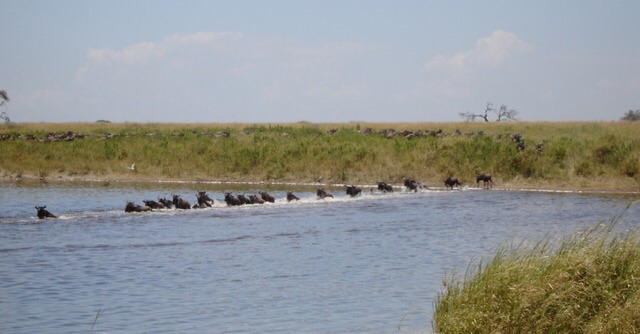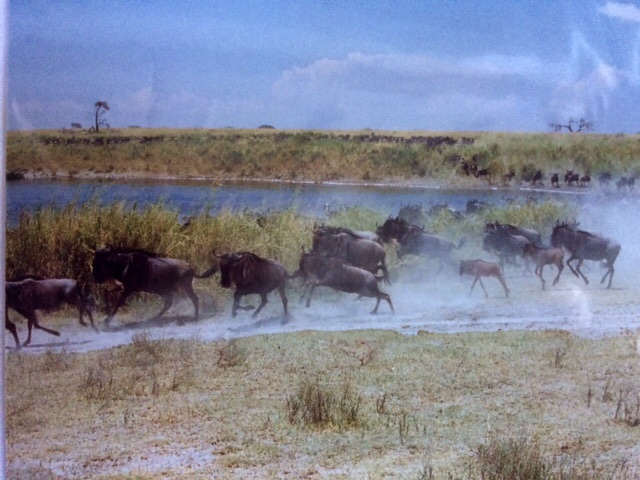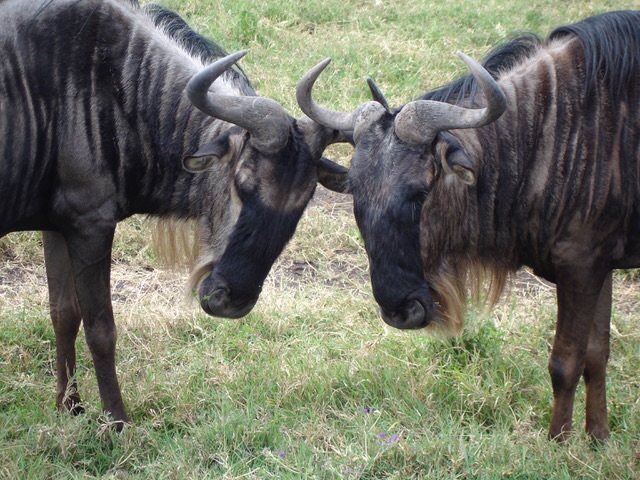The Serengeti was blue. Not only the sky but also the acacias; squares of vivid indigo material crowded out the leaves.
‘Tsetse fly traps,’ our guide explained.
I checked my trousers (dual purpose khaki: camouflage for game viewing and, supposedly, an unappealing colour to tsetse flies) were pulled down over my ankles and my shirt buttoned to the neck.
Tsetse flies and the parasitic disease they transmit – sleeping sickness – is something of a mixed blessing for the Serengeti. European colonisers avoided the area, sparing the wildlife the worst of the ravages it was subjected to elsewhere. However sleeping sickness still troubles the inhabitants of the villages hemming the park edges. Easy to treat if caught early, it is difficult to diagnose and impossible without appropriate healthcare. Hence the traps in this remote eastern corner of the park.
Perhaps the migrating herds are as big an attraction for the flies as for the tourists. Silent in our open-top jeep, we watched as wildebeest kettled themselves on a broad lip of earth overhanging a chocolate-brown river. The biggest and boldest tarried hardly at all, crashing through the group to hurtle into the water below, where they kept to the centre of the crowd of swimmers. Meanwhile, the current was bearing smaller animals sideways, dragging them closer to flotillas of log-like crocodiles and further from dry land. The hot air was thick with the cow-like calls of separated mothers and calves.

In the long, yellowed grass on our side of the riverbank, a lioness swivelled her head left, right and left again as wildebeest after wildebeest, streaming water, charged past her. Here and there, uneaten corpses showed it is not only foxes that get carried away in the presence of such plenty.

When the sun was half-gone below the horizon, we started the engine to drive past the stragglers – young calves, mostly, still calling with hollow desperation for their mothers. I tried not to think of the lioness on the riverbank. The road took us away from the great herd, which was heading north towards the greenness of the Maasai Mara, but not from all of their hangers-on.
I heard the buzzing first, beside my left ear, and flapped a hand at the sound. Silence. And then I looked down and saw the fly settling on my trousers, somewhere below my hipbone. When it scissor-closed its wings, I knew what it was. I raised my hand again to swat at it but the creature dipped its head as if in prayer, and bit through my trousers and underwear in one quick lunge.
There was blood – a surprising amount – and the bite hurt out of all proportion to the size of the fly but, as the evening deepened into the same indigo-blue as those tsetse fly traps, I counted myself lucky. I’d be watching for the symptoms, I had no fears about the quality of the medical care available to me – and I was not alone with lions on a riverbank.

[These events happened almost ten years ago so I’m guessing I’m safe from sleeping sickness. The piece was inspired by a sort out of my photographs on a cold day, when the heat, dust and indigo blues of the Serengeti seemed like a lifetime and another world away. Sadly, sleeping sickness continues to be a threat in much of sub-Saharan Africa and, to my knowledge, the campaign against tsetse flies is ongoing.]
luscious descriptions, Louise
LikeLiked by 1 person
Thank you, Geoff. Not as luscious as the Serengeti. Or the wildebeest to the lions…..!
LikeLiked by 1 person
No true
We watched the migrations back in 1988 and it was an utterly compelling experience
LikeLiked by 1 person
Just lovely, Louise – your descriptions of Africa are so powerful and full of life. You must have loved it there 🙂
LikeLiked by 1 person
Oh yes…. Still, the memories give me plenty to draw on.
LikeLiked by 1 person
I bet they do 🙂
LikeLike